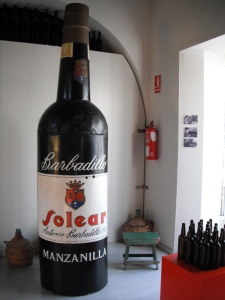The area between the cities of Sanlucar de Barrameda, Cadiz and Jerez de la Frontera is known as the sherry triangle and each of these cities contain sherry warehouses for well-known brands.
The names are surprisingly British: Osborne, Terry, Harvey and Sandeman. In fact it was possibly Sir Francis Drake who instigated the British interest in sherry when he sacked Cadiz in 1587 and stole 3000 barrels of the local wine.
There are 7 types of sherry ranging from very dry to very sweet.
| Manzanilla | dry and fresh | olives, almonds and sushi |
| Fino | very dry and pale | fish, shellfish and some cheese |
| Amontillado | off dry | chicken, rabbit, foie gras and blue cheese |
| Oloroso | dry, dark and nutty | game and red meat |
| Pale cream | 75% Fino & 25% Pedro Ximenez | fresh fruit |
| Cream | sweet | fruit cake and desserts |
| Pedro Ximenez | very sweet | chocolate and biscotti |
The process
 There are three types of grape used for the production of Sherry: Palomino, Muscat of Alexandria (Moscatel) and Pedro Ximénez. The Palomino is the dominant grape in the region as it produces large bunches of pale green grapes with a potential alcohol level of 11–12.5 degrees. The other two grapes are mainly used for sweetening purposes.
There are three types of grape used for the production of Sherry: Palomino, Muscat of Alexandria (Moscatel) and Pedro Ximénez. The Palomino is the dominant grape in the region as it produces large bunches of pale green grapes with a potential alcohol level of 11–12.5 degrees. The other two grapes are mainly used for sweetening purposes.
The grapes are pressed and allowed to ferment and a layer of yeast film forms on the top of the developing wine. This is called the flor, and it forms from yeasts in the winery environment when the sherry casks are left incompletely filled. Sherry butts (barrels) are made of American oak and usually have a capacity of 600 litres, but are only filled to 500 litres, leaving a large air space. The growth of the flor protects the developing wine from oxidation and contributes a distinctive flavour to the wine.
At the end of the year when fermentation is complete, the wine is classified and then fortified. The cellarmaster tastes wine from the different casks and separates out the lighter wines to become fino, and the heavier wines to become oloroso.

